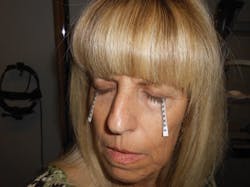The Schirmer Test: Dental professionals should be aware of connection between dry eyes and dry mouth
Multiple tests may be needed to assess various disease states involving the eyes and the lack of fluid that result in complaints of dryness. Sometimes patients may also complain about oral dryness as well. Some factors that may be involved in eye dryness include Sjögren's syndrome and other disease states, previous radiation, medications, aging, and laser eye surgery.
Additionally, tear composition composed of oil, water, and mucus may be altered for various reasons, affecting the eye environment. Determining the diagnosis related to dry eye is often a process of elimination and a list of differential possibilities (see related sidebar). The dental community is often part of this investigative process since dry eye and dry mouth may occur simultaneously and this is especially relevant in certain salivary gland diseases.
One such prime disease state that often involves dry eye would be Sjögren's syndrome. Patients who have Sjögren's syndrome often have difficulty in obtaining a definitive diagnosis. As with most chronic diseases, the progression of the disease occurs over time, and multiple tests are used to determine the health state of the patient.
Tests that assist diagnosis
Certain chronic diseases in addition to Sjögren's syndrome, have similar characteristics with symptoms such as dry eyes, decreases in saliva resulting in dry oral tissues, difficulty eating any dry foods, and complaints about joint pain. Multiple tests are often used to assess complaints relayed by the patient due to the wide range of subjective complaints. In most cases, it is usually a long process to determine a diagnosis. Beckman, et al. (2015) state that these patients often take an average of 3.9 years before being definitively diagnosed and treated.
Many complaints may be very subjective such as decreases in saliva, limited saliva production while eating, and a decrease in fluids within the eyes. Beckman, et al. (2016) state that a multidisciplinary approach is needed to manage patients with dry eyes from all causes, patients with Sjögren's syndrome, and the need to identify these patients early in the exam process. Although rheumatologists manage these issues related to Sjögren's in many cases, other medical and dental professionals are a part of this identification and treatment.
The Schirmer Test
A test called the Schirmer's test may be part of a patient's record or may be referenced in a pathology report. A patient may also refer to the test. Sometimes both hygienists and dentists are not familiar with use of this test.
A patient may ask for comments or opinions from the dentist or hygienist. The patient is not familiar with what the results really mean and may need some explanation. The purpose of this column is to refresh or acquaint the dental professional with the use of the test and what the results may indicate for the patient.
Essentially, a paper filter strip is placed touching lightly inside of the lower eye lid (see Figure 1). The clinician then evaluates the markings on the filter paper is that is moistened by tears (the paper will turn a tan/gray color when wet, indicating a marking line). A time limit of five minutes is standard. The tan marking indicates a range of 30mm for the patient in Figure 1.
When less than 5mm (indicated on the strip) of the paper has been wetted within the five-minute period, an abnormal reading is recorded (see related sidebar). The patient has not produced enough tearing to gain a normal response for the test.
The test is a good, simple test to determine if the patient is not producing enough eye liquid. Since many of the complaints by the patient may be borderline or very subjective, this gives the clinician more concrete evidence that dryness is occurring.
Other more extensive testing would be needed when an abnormal response occurs, depending upon the symptoms being reported. Some criticism of the tests may be that it should be evaluated with more extensive tests and performed by someone such as an ophthalmologist with a special interest in dry eyes.
Vivino et al. (2016) state a key point in a recent article: "Proper treatment of dry eyes necessitates comprehensive assessment to determine severity level and the relative contributions of aqueous tear deficiency (ATD) versus meibomian gland dysfunction."
Meibomian glands are tiny oil glands that line the inner lids of the eyes-where eyelashes meet the lid of both upper and lower lids. The oil production may be less than normal or the quality may be inadequate. The authors state that salivary disease is the most difficult to evaluate and to manage of all the chronic autoimmune disease states. Sjogren's syndrome is costly since most patients do pay some, if not all, out of pocket costs and many do not have dental coverage. When dry mouth is an issue-regardless of the cause-the rate of caries is higher, leading to more restorative procedures and extractions.
Causes for dry eye
- Aging
- Gender
- Women due to hormones
- Health conditions, including:
- Diabetes
- Rheumatoid arthritis
- Lupus
- Scleroderma
- Sjögren's syndrome
- Thyroid problems
- Vitamin A deficiency
- Rosacea and other skin problems
- Chronic conjunctivitis
- Allergies
- Meibomian gland dysfunction
- Eye conditions, including:
- Contact lenses usage
- Refractive eye laser surgery (temporary)
- Eyelid problems
- Eye injury or damage
- Tear gland damage from:
- Imbalance of tear composition in mucus, water, oil
- Inflammation of edge of eyelid and surface of the eye
- Radiation
- Blocked glands
Medications that cause dry eye
• Antihistamines
• Decongestants
• Hormone replacement therapy
• Antidepressants
• High blood pressure
• Acne medication
Tear evaporation causes
Blinking less often promotes dryness while concentrating on task involving:
- Prolonged reading
- Computer usage
- Driving
- Watching television
- Hair dryers
- Environmental exposures
- Air quality
- Dry climate
- Dusty conditions
- High altitudes
- Smoke and tobacco
- Chemical irritants
- Sleeping with eyes partly open
- Windy situations
- Air conditioning (especially in a car with direct focus on the eye area)
- Fans (especially while sleeping)
- Heaters
Reduce dry eyes with:
- Over-the-counter artificial tears
- Increase air humidity
- Wear sunglasses or regular glasses
- Nutritional supplements
- Avoid dehydration by limiting caffeine
- Drink plenty of water throughout the day
- Massage eye-rubbing gently to stimulate tears
The Sjogren connection
Sjögren's disease is often the cause of severe dry eye complaints and oral dryness. It is an autoimmune disease exhibiting both dryness of the eyes (xerophthalmia and also keratoconjuctivitis) and the oral tissues (xerostomia). When both dry eyes and dry oral tissues are present, the term used is sicca syndrome. There is abnormal production of antibodies that are directed toward certain tissues in the body. The glands involved in tear production (lacrimal glands) and saliva production (salivary glands) are targeted. This is termed Primary.
When connective tissue diseases such as rheumatoid arthritis, systemic lupus erythematosus or scleroderma are involved, the term secondary is used.
The majority of cases of salivary disease is found in women, and the disorder is often found in families (genetic propensity) who have other autoimmune type diseases such as thyroid issues, type 1 diabetes and systemic lupus erythematosus. Sjögren's disease is the second most common autoimmune disease with rheumatoid arthritis being the first. According to the Sjögren's Syndrome Foundation, an estimated two to four million people are affected in the United States.
Dental professionals are key in identifying dry mouth and dry eyes in their practices. No other professional is in such close proximity to these areas, and early diagnosis followed by treatment is crucial. Patients will seek dental treatment when dry mouth is a problem, and the dental professional will be involved in trying to determine the cause of the dryness. The combination of this lack of lubrication in the eyes and mouth is usually voiced in the complaints from the patient. Patients may voice symptoms such as grittiness of the eyes, redness, burning, lack of tears, pruritus, blepharitis, and both oral or nasal dryness.
Other diseases can be responsible for dryness and certain medications that are being used by the patient for treatment of these diseases may play a role (see related sidebar). The oral practitioner must assess the origin of the dryness as well as the severity. Utilizing the Schirmer test could be a starting point in referral of the patient for more sophisticated tests and treatment.
Oral medicine perspectives
A useful self-help booklet is available through the Sjögren's Syndrome Foundation (see the references). Dental professionals can assist their patients by not only recommending products to alleviate dryness but also by suggestions that they modify lifestyle factors, improving the quality of life for these patients. The patient is often given a diagnosis with many statistics and information related to their disease, but assisting them in "living with a chronic disease" is so beneficial.
The Schirmer Test is only one test that could assist the practitioner in confirming that the patient is justified in pursuing additional tests to solve the issues related to dryness. As dental professionals, we are in such a unique position to offer patient education to all patients. We are also in a perfect position to identify disease states in which early detection can make a huge difference in the patient's health and long-term management. Working with others in various health care disciples is the wave of the future.
As always, continue to ask good questions, and listen to your patient.
Author acknowledgement: Thanks to Carol Perkins, RDH, BA, AS, who contributed information used in the two sidebars. Carol is a practicing clinical hygienist in the San Francisco Bay Area.
References
1. Beckman KA, Luchs J, Milner MS. Making the diagnosis of Sjögren's syndrome in patients with dry eye. Clinical Ophthalmology: Dec. 2015; 10:43-53.
2. Neville BW, Damm DD, Allen CM, Chi AC. Oral and Maxillofacial Pathology. 4th edition, 2016.Elsevier, Inc.
3. Vivino FB, Carsons SE, Foulks B, Daniels TE, Parke A, Brennan MT, Forstat SL, Scofield RH, Hammit KM. New Treatment guidelines for Sjögren's Disease. Rheum Dis Clin N Am 2016 42: 531-551.
Originally published in 2016 and updated regularly.
About the Author
Nancy W. Burkhart, EdD, MEd, BSDH, AAFAAOM
NANCY W. BURKHART, EdD, MEd, BSDH, AAFAAOM, is an adjunct professor in the Department of Periodontics-Stomatology, College of Dentistry, Texas A&M University, Dallas, Texas. She is founder and cohost of the International Oral Lichen Planus Support Group (dentistry.tamhsc.edu/olp/) and coauthor of General and Oral Pathology for the Dental Hygienist, now in its third edition. Dr. Burkhart is an academic affiliate fellow with the American Academy of Oral Medicine, where she also serves as chair of the Affiliate Fellowship Program Committee. She was awarded the Dental Professional of the Year in 2017 through the International Pemphigus and Pemphigoid Foundation, and she is a 2017 Sunstar/RDH Award of Distinction recipient. Her professional interests are in the areas of oral medicine and the relationship between oral and whole-body health, with a focus on mucosal disease and early oral cancer detection. Contact her at [email protected].

